Knowing the Basics Could Make All the Difference
By Sergei Poljak
Each year, avalanches claim the lives of approximately 150 backcountry enthusiasts, making them the most frequent cause of death amongst ski tourers and freeriders (63% of fatalities). Knowing the basics of avalanche forecasting and rescue will make you a more valuable ski partner, keeping yourself and others safe during a long career of fulfilling mountain adventures.
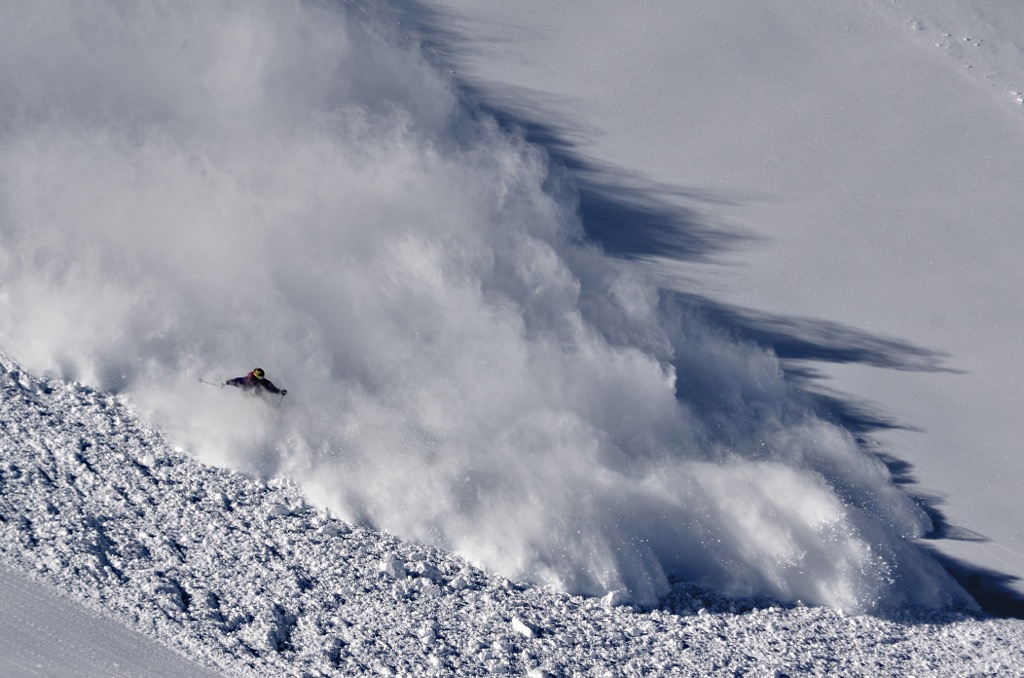
What Are Avalanches?
At their most basic level, avalanches are masses of snow, ice, and rock moving down a mountainside, powered by gravitational force. While these are the common denominators of avalanches, nearly all their other characteristics vary. They can be tiny or massive, slow or fast, high or low elevation, predictable or seemingly random.
In PeakVisor’s Guide to Avalanche Safety, we dive into some of the introductory science behind avalanches, techniques for safety, and, lastly, a discussion of risk and why avalanches shouldn’t prevent you from experiencing the joy of backcountry skiing.
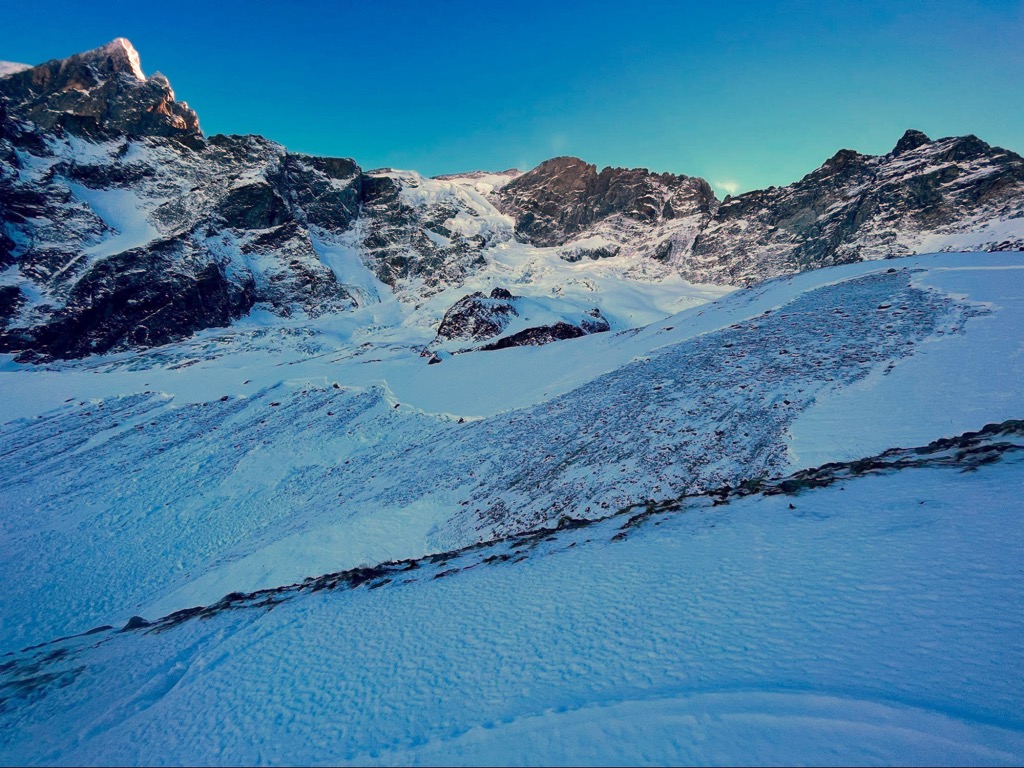
Please note: When it comes to avalanches, no online article or video can substitute for comprehensive instruction and firsthand experience. This article is simply an introduction to the world of avalanches.
Types
There are several types of snow avalanches. Here is an introduction to the most important ones you’ll encounter as a skier.
- Slab Avalanches are the most common type of avalanche involved in skier accidents. Nearly all ‘pure snow’ avalanches are slab avalanches, meaning that a block of snow breaks off the mountain and rapidly travels downward in a cohesive unit.
- Persistent Slabs are caused by a weak layer within the snowpack that can release under the weight of a skier, causing the cohesive mass of the snowpack above it to travel downward. Persistent slabs are the most dangerous because they tend to be hard to predict and can be very large depending on how deeply the weak layer is buried. If the weak layer is buried near the ground's surface, it’s called a deep persistent slab. Older persistent slabs may also be hard slabs, which are compacted and dense (hard to push a finger into).
- Storm Slabs refer to a cohesive layer of snow from a recent storm. These are, generally speaking, soft slabs, meaning the cohesive block of snow is yet to consolidate and is still loose and powdery.
- Wind Slabs are cohesive slabs formed by wind compaction and loading. They can be either soft or hard.
- Wet Slabs are blocks of heavy, wet snow that can break off during rain events or prolonged warming of the snowpack.
- Point Releases are small avalanches that release from one specific point rather than a cohesive slab. These can happen due to several factors, including the sun's effect and fresh snow.
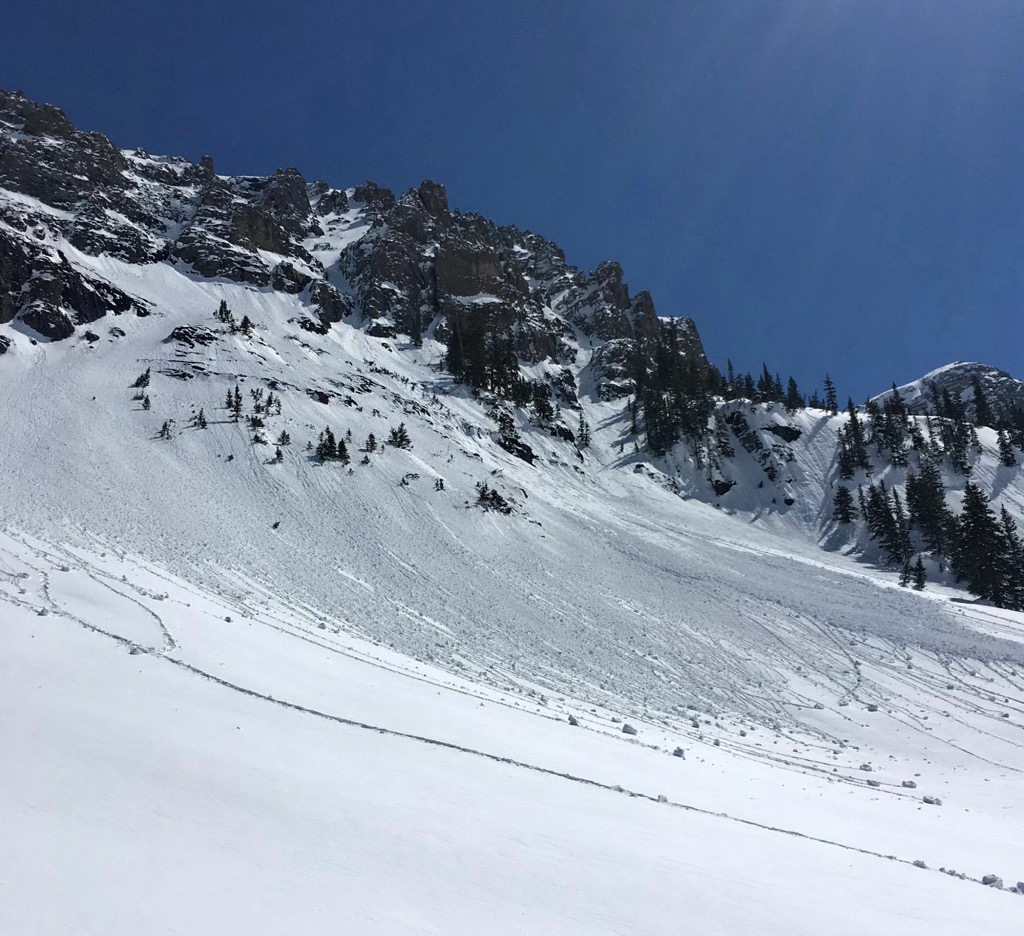
Little point releases sloughing off a sunny cliff after fresh snow on a spring day. Photo: Sergei Poljak - Cornice and Serac Falls can trigger large, destructive avalanches. Cornices are large overhangs of compacted snow, usually above a sharp ridge. Seracs are similar; they are large, overhanging blocks of glacial ice. These events are difficult, if not impossible, to predict and are usually not skier-triggered (rarely, cornice falls are skier-triggered). Generally speaking, sometimes rapid springtime warming can cause seracs and cornices to break off. Seracs also tend to shed off in the summer as a glacier melts.
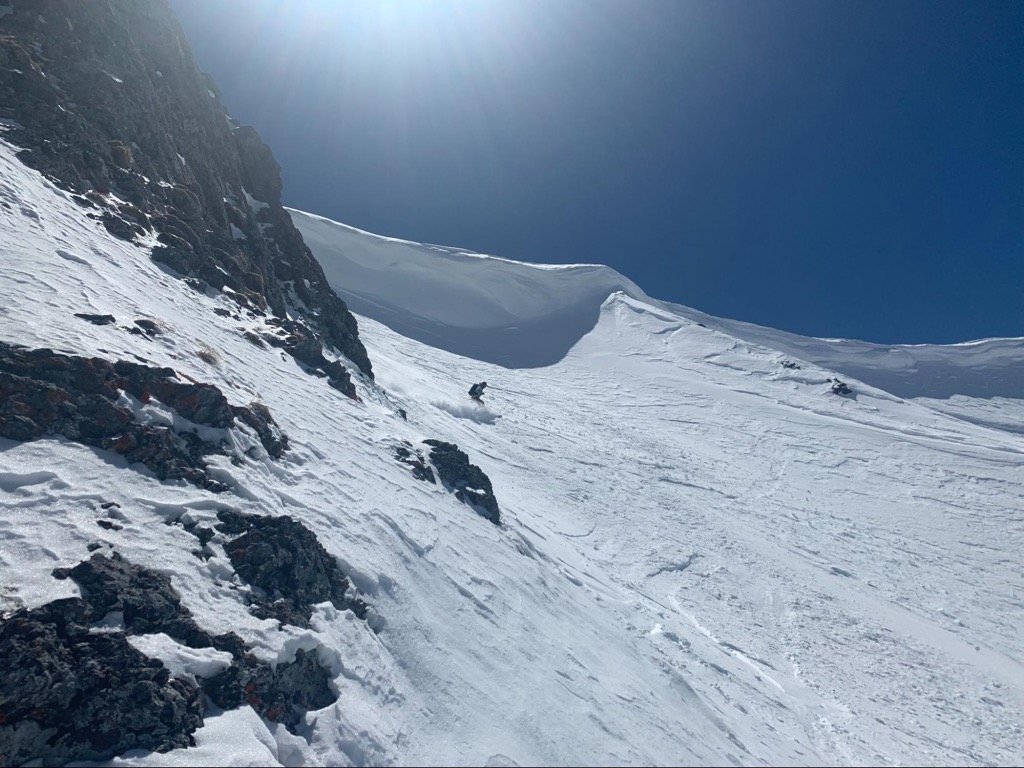
Size
Avalanches can occur in all shapes and sizes. Slough (pronounced ‘sluff’) is the smallest-sized avalanche. Spindrift is when the wind blows loose, dry snow from the top of the snowpack down the mountain. Spindrift is an annoyance but rarely an immediate threat save for causing frostbite or visibility issues. Slough can also be loose snow kicked up by skiers as they descend a slope. On steep slopes, slough can travel quite fast and knock a skier off their feet.
Meanwhile, slab avalanches can range from the footprint of a car to a football field to a square kilometer or more. A large slab can weigh a million tons and travel several kilometers down a mountainside. Most slabs, even smaller ones, can carry a skier over cliffs or through trees and bury them if the conditions are right.
The largest avalanches, full glacial or mountainside collapses, can destroy everything in their path, including entire towns. They can reach speeds exceeding 320 kph (200 mph) and travel dozens of kilometers. To be in the path of one of these slides would result in utter obliteration, as if by a bomb.
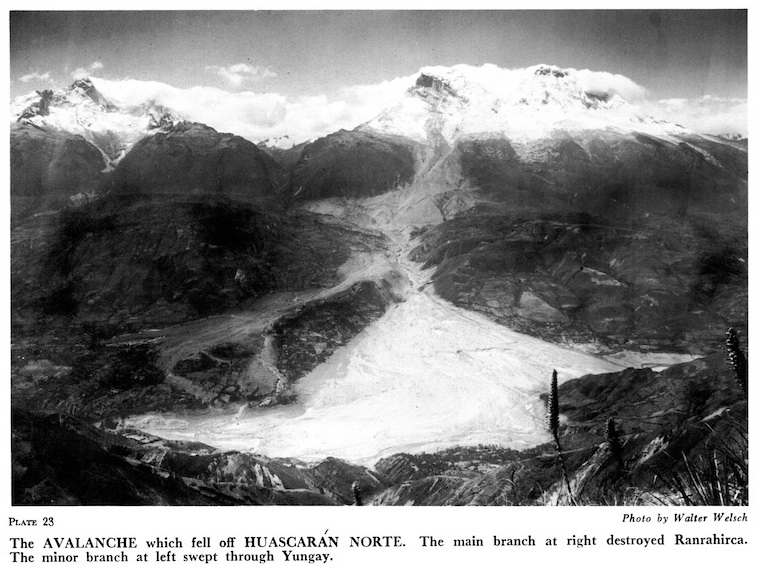
Terminology
Here’s some basic terminology with avalanches:
Crown: the fracture of a slab where it breaks away from the snowpack overhead.
Bed Surface: surface on which an avalanche runs.
Deposit: the avalanche debris at the bottom of the slide.
Runout: the lowest part of an avalanche where it slows and eventually stops.
Start Zone: the top of an avalanche, where the slab breaks away from the surrounding snowpack.
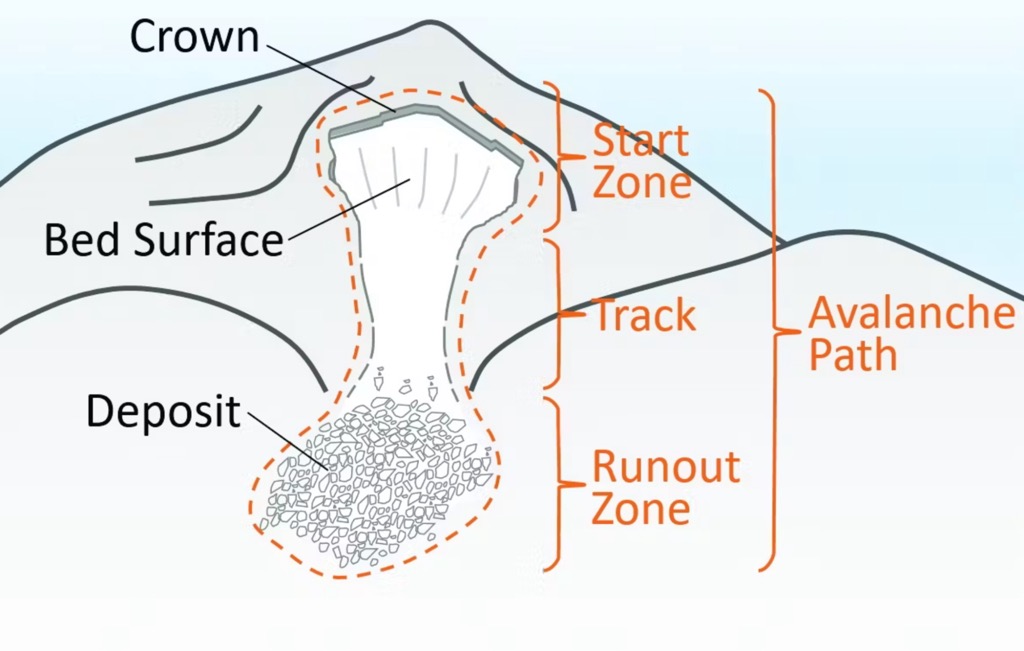
Essential First Steps to Prepare for Avalanches
Experience in the field will ultimately be the most important teacher. Nevertheless, every skier should commit to a few steps to dial in their avalanche awareness.
- Before you ski off-piste, buy the requisite safety equipment, i.e., a beacon, shovel, and probe. The only thing worse than not knowing how to use your beacon is not having one at all. The next step is learning how to use this equipment efficiently.
- Read a book on avalanche safety. My favorite is Bruce Tremper’s Staying Alive in Avalanche Terrain.
- Take an avalanche safety class. The organizations running these programs will vary from country to country, but they should be easy to find in the U.S., Canada, the U.K., the European Alps, New Zealand, and Chile/Argentina. Classes are usually a few days long and are incredibly informative. Oh, and don’t worry, folks; you’re surrounded by other backcountry enthusiasts, so this isn’t like grade school. You’ll be sure to have a good time and maybe meet some partners - ones who, like you, have been educated on the basics of avalanche awareness.
- After you’ve taken a class, practice relentlessly with your beacon, shovel, and probe. Work on finding hidden beacons in deep snow in the woods; practice throwing your probe in the air and snapping it closed with one fluid motion; and find snow banks in parking lots where you can dig into the type of concrete snow that comprises avalanche debris. I would rather ski with a partner who knows how to use their gear efficiently than one who has taken a class and never practiced.
If you complete these steps, you are most likely more dialed in than most backcountry skiers. Especially in Europe, I often see skiers far off-piste with no gear and exercising little to no awareness of their exposure to avalanches, let alone other hazards.
Where Do Avalanches Occur?
Avalanches can occur essentially anywhere on the mountain. The adage goes, “If it’s steep enough to ride, it’s steep enough to slide,” or “If there’s enough snow to ride, there’s enough snow to ride.”
Slides have been observed at every slope angle above 15° on every type of terrain, whether it be glacial ice, rocky slopes, grassy hills, or even dense forests.
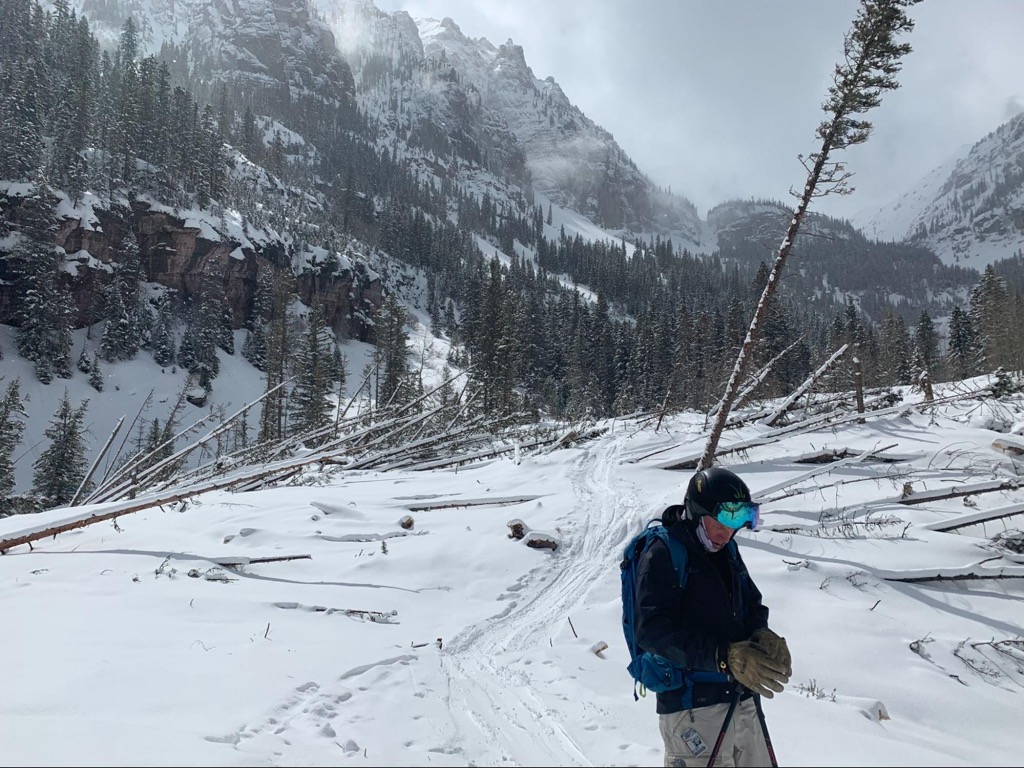
Terrain
Here are some tips for discerning what terrain presents the most avalanche risk.
Slope Angle
Slope angle is one of the most critical factors for recognizing avalanche terrain. The vast majority of skier-triggered avalanches occur on slopes between 30 and 45° (also the best angles for skiing). These slopes are steep enough to slide but less likely to do so naturally than, say, a 50° slope. While steeps have their own set of risks involved, they are often less dangerous from an avalanche perspective - any weak layers have long since fractured away naturally.
They make small protractor-like devices to measure the angle of a slope, but I’ve never seen anyone carrying one of these around. Smartphone users will likely have an app on their system (the Measure app on iPhones). You can get pretty good at eyeballing the terrain and knowing what angle it is within a few degrees.
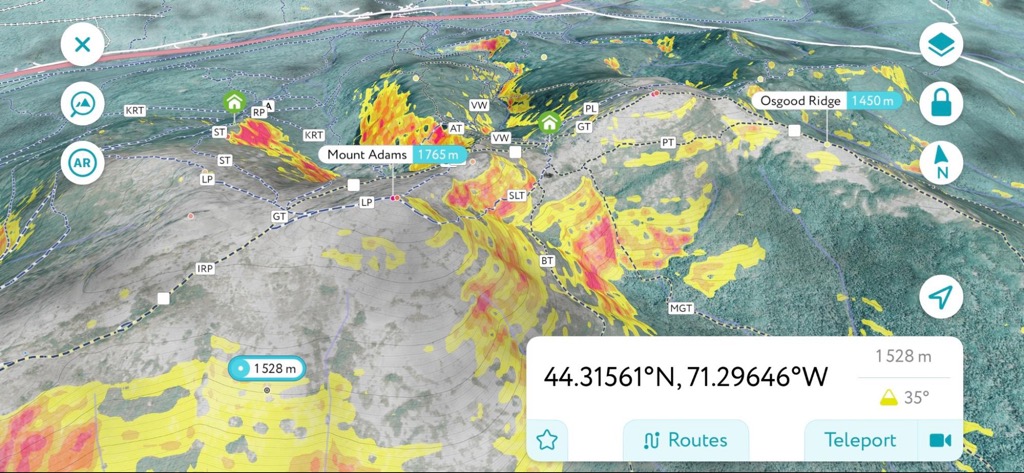
Concave vs. Convex vs. Planar Slopes
- Concave Slopes begin mellow and roll over into steeper terrain, with the drop-off being a frequent start zone for skier-triggered slides. Moreover, you often can’t see past the rollover; they are blind. Skiers reach this terrain quickly, without time to process the change in slope angle.
- Convex Slopes are often more desirable for skiing because they are less dangerous than concavities and, on a large scale, tend to collect more snow. Bowls are an example of convexity. Slabs on these slopes tend to be more supported by the snow below, and because the slope angle mellows out instead of steepening, avalanches don’t travel as far. A true convexity will feature a mellow runway at the bottom, where slides can run without causing trauma or deep burial of skiers.
- Planar Slopes, such as a long face, continue at a continuous angle for a distance. Avalanches can run a long way on these slopes, but the constant slope angle makes them easier to gauge than concavities.
Aspect
Aspect, or the direction a slope faces, can make a critical difference in a slope’s slide potential. Problems in the snowpack change daily and vary from region to region, so it’s difficult to generalize. However, two avalanche problems are relatively consistent from region to region.
- South-facing slopes tend to have avalanche problems related to the sun’s effect. Even in winter, the sun’s rays can set off wet slabs in the afternoon. Meanwhile, new snow can bury crusty, sun-affected snow and form weak layers for the next round of wet slabs.
- North-facing slopes often develop and retain weak layers. Pea-sized granular crystals that can form on the bottom of the snowpack are the most significant concern, particularly in dry, cold areas (i.e., Colorado, USA). These crystals are called facets and are the product of something called temperature gradient, basically the difference in temperature between the ground (closer to freezing level) and the snow and air above (well below freezing). Facets act like ball bearings, making it possible for skiers to trigger large slab avalanches that run to the ground.
- Note: These directions are reversed in the Southern Hemisphere.
These are generalizations; you’ll find facets on south-facing slopes and wet slabs on north-facing ones. So many factors go into the transformation and movement of snow. But they serve as examples of how vital the aspect is.
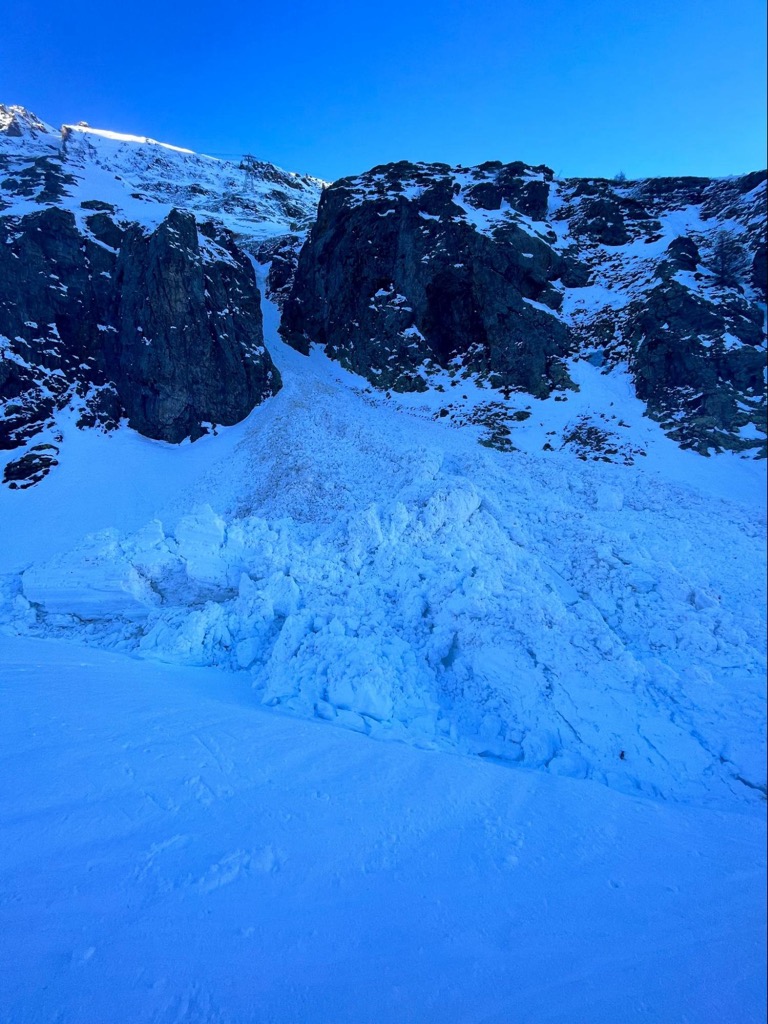
Alpine vs. Trees
Alpine slopes tend to have more complex avalanche problems than slopes below treeline. Alpine areas are higher in altitude, and altitude is subject to more snow and wind, two key ingredients in avalanches. Therefore, large cohesive slabs - the kind that are deadly to skiers - are more likely to form.
While it’s debatable how effectively trees anchor the snowpack in place, we know they are at least more effective as anchors when the snow is slabby rather than loose.
In my years of skiing, I’ve seen many avalanches in the trees and the alpine terrain above; I don’t let my guard down at all in the trees. Even though I’ve seen more slides in the alpine and I believe that, overall, it is more likely to trigger a slide in the alpine, there is a critical disadvantage with trees. Avalanches travel extraordinarily fast, and trees become lethal obstacles when you’re enmeshed in that tumbling mass of snow.
About half of avalanche deaths are burials, and half are trauma; that is to say, half of people die because they asphyxiate under the snow, while the other half perish because they get thrown over cliffs, hit with rocks, or nailed up against trees. The data is sparse, but trees seem to account for the majority of those trauma deaths. It’s also true that many of these accidents started with skiers caught well above the treeline and getting swept into trees from above.
Geographic Location
Location is enormously important for avalanche awareness because climates produce different avalanche problems. I’ll go into this in greater detail in the next section, but there are three fundamental types of snowpack: Maritime, Intercontinental, and Continental. Maritime snowpacks are generally the most stable, while continental ones are the least.
Whenever I ski somewhere, I have a general idea of where that location falls on the spectrum. If I’m in Europe, I know I’m likely dealing with an intercontinental snowpack, while if I’m in Colorado, it’s likely a continental snowpack. In Europe, you can ski some steep slopes in December, even during avalanche-prone winters. In Colorado? Not so much. Those same slope angles might be off-limits until March or April.
Climate and Weather
Climate is the average weather over a long period, while “weather” is near-term atmospheric events. Both make a significant difference in avalanche forecasting.
Climate dictates whether a region’s snowpack is Maritime, Intercontinental, or Continental, and weather dictates where on that scale a region's snowpack may end up over a given week during the winter.
Types of Snowpack
Maritime
Maritime snowpacks are historically the most stable and skier-triggered deep persistent slabs are much less common than in a continental snowpack. Why is this?
Climates with relatively warm, moist air feature significant snowfall, with much of the accumulation occurring at temperatures near the freezing level. Warm air can hold more moisture, thus leading to high rates of precipitation. A maritime snowpack will often be very deep; five meters (17 feet) is not uncommon. While there may well be weak layers buried there - few midwinter snowpacks are 100% bonded - a skier is not likely to put any pressure on these layers. Skiers only influence the snowpack about one meter below their skis, so deep snowpacks are more stable.
Another reason maritime snowpacks are safer is because there is less temperature gradient (TD) in these climates. I mentioned this word earlier, and it’s an important one to know. TD causes granular, rounded snow crystals, called facets, to form. When facets form in a snowpack, they provide such poor friction that a skier can easily trigger lethal-sized slab avalanches. Even if you could find facets in a maritime snowpack, they are so far down that the force of a skier is not enough to sway them one way or the other.
Maritime snowpacks still have their own avalanche problems. Storm slabs are often an issue because these regions can get enormous amounts of snow at once. Wind slabs can build to stupendous proportions, especially in areas like California that usually receive wind with storms. Check out journalist John Branch’s Pulitzer Prize-winning article on an infamous 2012 avalanche in Steven’s Pass, Washington, USA (an area that typically boasts a maritime snowpack).
Where in the world can you find Maritime snowpacks? Well, close to water, as you might’ve guessed. You need a large body of water to generate the warm, moist air that feeds a maritime snowpack. The entire west coast of North America, from the Sierra Nevada of California to the Aleutians Chain of Alaska, features this type of snowpack. Southern Chile and Argentina - the Patagonia region - are also maritime, but they don’t have ski resorts that far south. Coastal Norway could likely be considered maritime in most years, but they do not get as much snow as the locations I mentioned above.
Continental
Continental snowpacks are the most finicky for skier-triggered avalanches. These occur in desert regions with mountains that receive moderate snow. Areas with the most infamous continental snowpacks include the Four Corners of the USA: Colorado, New Mexico, Arizona, and Southern Utah. Interior Argentina around Las Leñas is also likely continental. Vast expanses of mountains in China, Mongolia, Kyrgyzstan, and other Asian countries also likely feature continental snowpacks, although these are remote places where even climbers seldom venture, let alone ski.
Continental snowpacks are avalanche-prone for two main reasons. First of all, the temperature gradient is extreme. Bitterly cold, dry nights create a massive temperature differential with the bottom of the snowpack, with hovers around freezing level. The temperature gradient encourages the formation of granular facets, which act like ball bearings. Skiers can sometimes trigger weak points in these layers, and cohesive slabs containing the entire season’s snowpack have been known to break off.
Facets usually form in the early season, when a small layer of new snow is blanketing the mountains. In continental climates, this layer is buried by additional cold, dry snow, and the facets don’t heal. In maritime climates, warmer air, rain, or heavy wet snow can heal facets that do form (although conditions are less conducive to their formation in the first place). In continental climates, facets can also form mid-season and become buried, creating a persistent slab problem.
The second reason is that continental snowpacks are typically far more shallow than intercontinental or maritime snowpacks. Because skiers can only affect weak layers within a meter of the surface. If they do form, early-season facets are quickly covered by meters of snowpack in maritime climates and usually break off or heal by themselves. The force of a skier is not nearly enough to impact these layers.
Intercontinental
Intercontinental snowpacks are in between maritime and continental. They include most European and South American resorts, and areas of northern Utah, Idaho, Wyoming, Montana, and interior B.C. in North America.
Intercontinental zones can exhibit maritime or continental snowpack traits depending on the weather. There can be extended periods of heavy, wet snow building a bombproof base layer or periods of cold, dry weather that facilitate the formation of facets.
Managing Your Risk in Avalanche Terrain
Avalanches are widespread. In a hypothetical scenario where skiers simply went out and skied whatever they wanted, whenever they wanted, with no knowledge or regard for avalanches, most would be dead within a season or two (Bruce Tremper discusses this hypothetical in more detail in his book). Yet, most backcountry skiers live long, fulfilling lives. That’s because we are constantly assessing and managing risk in these environments.
Avalanche Safety Gear
Avalanche safety gear is mandatory in the backcountry. It’s like wearing a helmet mountain biking; you simply don’t go without it.
Beacon, Shovel, Probe
The basics are a beacon, shovel, probe, and, if you don’t already ski with one, a backpack to fit the shovel and probe.
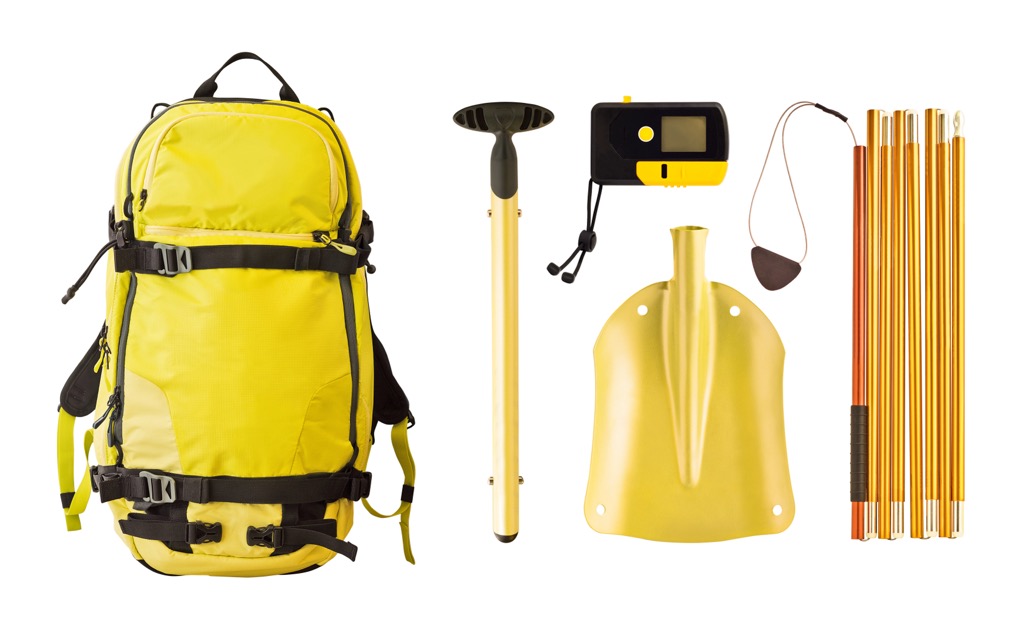
Beacons, also called beepers, transceivers, peeps, and other names, are radio transceivers, meaning they both transmit and receive radio signals. You wear a beacon strapped to your chest so that, in the event that you get buried by an avalanche, your partners can locate and dig you out. Here are a few things to note about beacons:
- While skiing, the beacon remains in ‘send’ mode and only goes into search mode when you're looking for someone.
- Beacons don’t require much maintenance, save for two critical things:
- First, you must remember to turn your beacon on. I turn on mine as soon as I put it on, even at home. Then, it doesn’t go off until the day’s skiing is complete. I don’t turn it off for lunch or anything else, lest I forget to turn it back on again.
- Secondly, you must regularly check the batteries. I swap my batteries out when they reach about 60% and use them in my headlamp. I carry extras in my pack as well. Search mode uses a lot of battery, which is why you must switch them out before they get too low. You don’t want to get to the scene of an accident and run out of battery a few minutes into your search.
- Most beacons have a search radius of about 40 - 70m (130 - 230 ft).
- Neither I nor PeakVisor are affiliated with Mammut, but my Mammut Barryvox has always performed exceptionally well during practice beacon searches, picking up signals earlier than other beacons.
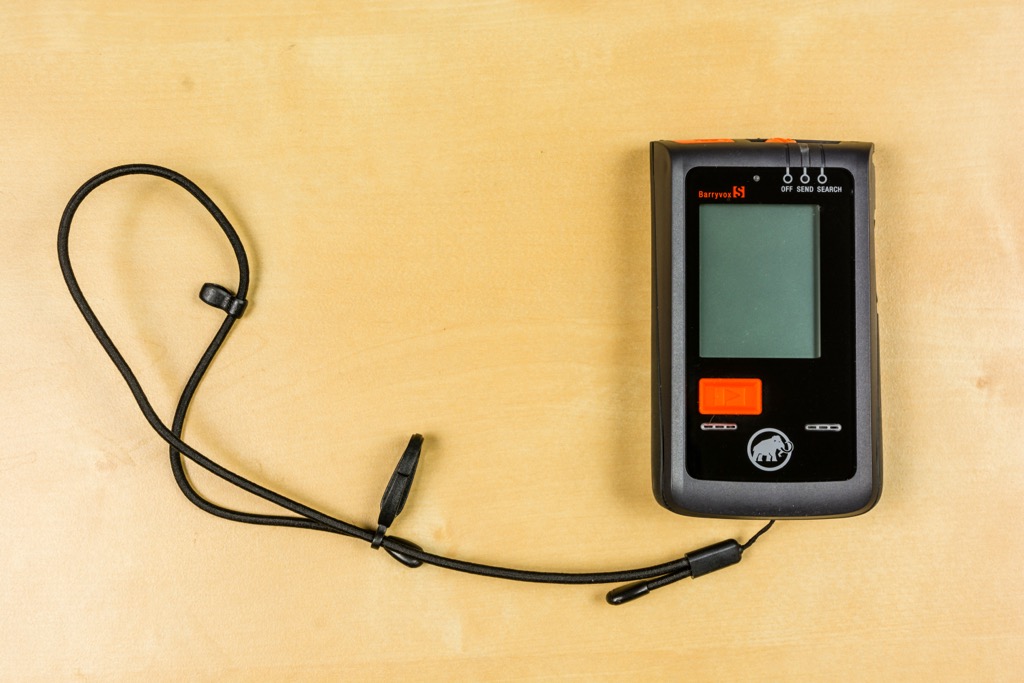
Once you locate a victim with your beacon, it’s time to use your probe to find their body and mark the spot. Most probes are about 2.5 meters (8.2 feet) long. If the victim is buried deeper than this, you won’t be able to dig them out anyway; avalanche debris is the consistency of slightly wet concrete.
Lastly, we carry avalanche shovels to do the digging. Ensure you have a strong shovel with a sharp metal blade. Cutting through the debris will be much more laborious than people realize.
These three things are mandatory kit for any backcountry snow traveler.
Avalanche Airbags
Enter the world of avalanche airbags. These devices have been a hot topic for the last decade amongst skiers, riders, and snowmobilers.
The evidence shows that wearing an avalanche airbag saves at least as many lives as wearing a beacon. Bruce Tremper says, “Although it's impossible to directly compare beacons with avalanche airbags because it's an apples-and-oranges comparison, most experts agree that the avalanche airbag will likely save more lives.”
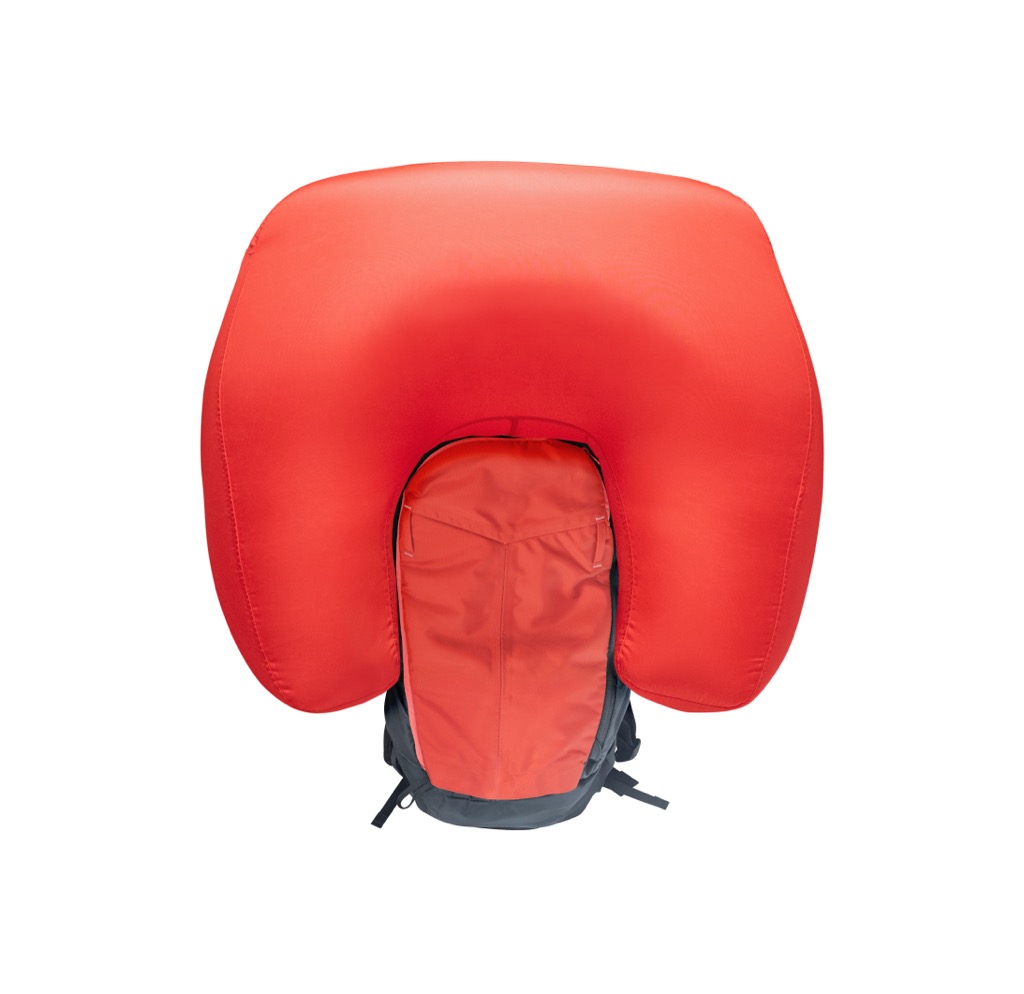
They may be more effective than beacons because even if you locate a partner with a beacon, digging through avalanche debris is so difficult that many people cannot do it fast enough, and the victim perishes. Victims can survive for as little as ten minutes and no more than 25 minutes under the snow. You’re already fighting an uphill battle if somebody has been buried. Not getting buried in the first place is crucial.
Many experienced skiers and riders still criticize avalanche airbags in a stand-off reminiscent of the same group’s reluctance to wear helmets. Airbags have faced criticism, with these being the main talking points I’ve heard:
- They’re heavy. The weight tires you out, which is more dangerous than the benefit of not getting buried (debatable, but at least not logically flawed).
- Skiers take more risks. (Counter argument: do beacons make skiers take more risks, too? Do seatbelts make drivers take more risks?)
- They are just for fashion. It’s true; these have become something that affluent skiers wear to look cool, like many expensive things in the outdoor industry. That doesn’t mean they don’t work.
- They don’t work in terrain where you’re likely to die by trauma (i.e., cliffs, trees). It’s true airbags are more effective in places like Europe, with vast alpine slopes above treeline. Nevertheless, they’re documented to have prevented burials all over the world.
- It’s hard to pull the trigger when you get caught. In truth, it’s not that hard at all.
The weight is definitely significant; it’s especially noticeable for smaller people. I only wear my pack when I feel that there is a considerable avalanche risk that day. But the potential benefits outweigh the pack's weight for me and many others. I ski in an area defined by open alpine terrain where burial without trauma is a likely outcome in the event of a slide.
How Do Airbags Work?
Airbags are simple. It’s like a standard backcountry pack but with a trigger around the chest (without the trigger and branding, you wouldn’t be able to tell the difference). The trigger leads to a compressed gas canister or a small motor. These components then inflate sacks stuffed away in the pack into large balloons.
When you get caught in an avalanche, your body is denser than the surrounding snow, and you tend to sink, especially as the avalanche slows at the end of its path. The inflated balloon acts as a buoy in these situations. They can also act as a bumper around your head and back and prevent some trauma, although this is not their primary purpose.
Avalungs
A third piece of gear is called an ‘avalung’ (literally the manufacturer's brand name).
When you get buried in a slide, you die from inhaling your own CO2 instead of oxygen.
Avalungs are like snorkels you put in your mouth while skiing or if you get caught in a slide. The device contains a cartridge that filters out some CO2 and diverts it from your mouth so you don’t asphyxiate on your exhalations.
They are not popular. Skiing with them in your mouth is uncomfortable, and they’re difficult to put in your mouth quickly, i.e., if you get caught. The best use case is to use them as an actual snorkel to breathe in deep powder.
Avalanche Forecasts
If all this information seems overwhelming, that’s because it is. I haven’t even gone into a fraction of the science behind avalanches in this article. How are you supposed to go out and decipher the snowpack on your own?
The good news is, you don’t have to. There are people with PhDs in snow science, and many of them lead happy, fulfilling lives as avalanche forecasters in the world’s mountainous regions. It’s not just for skiers; there are avalanche forecasters for infrastructure like roads and towns.
These fine men and women do all sorts of experiments you don’t have the knowledge or time to do. They dig pits and analyze snowpacks. They initiate compression tests to scope out weak layers. Some drop bombs and see if big slides propagate.
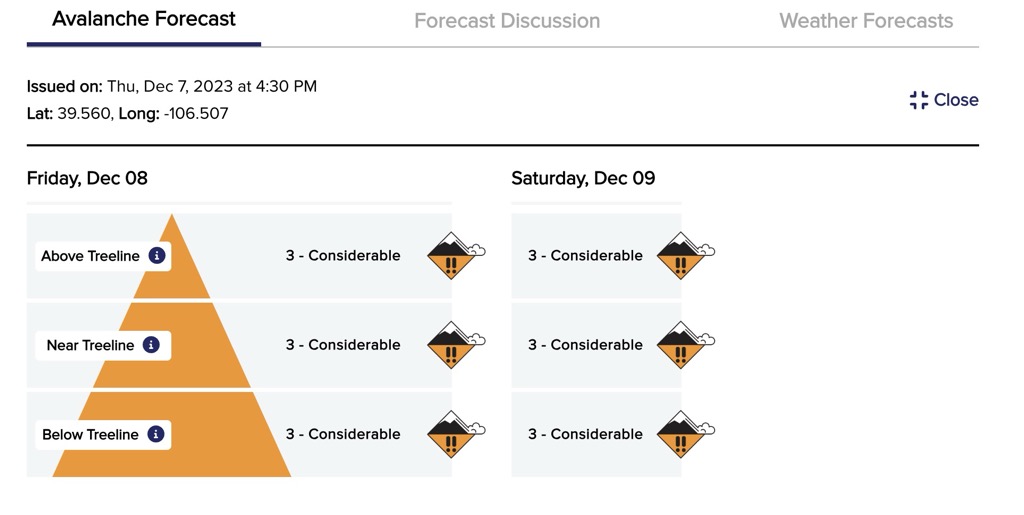
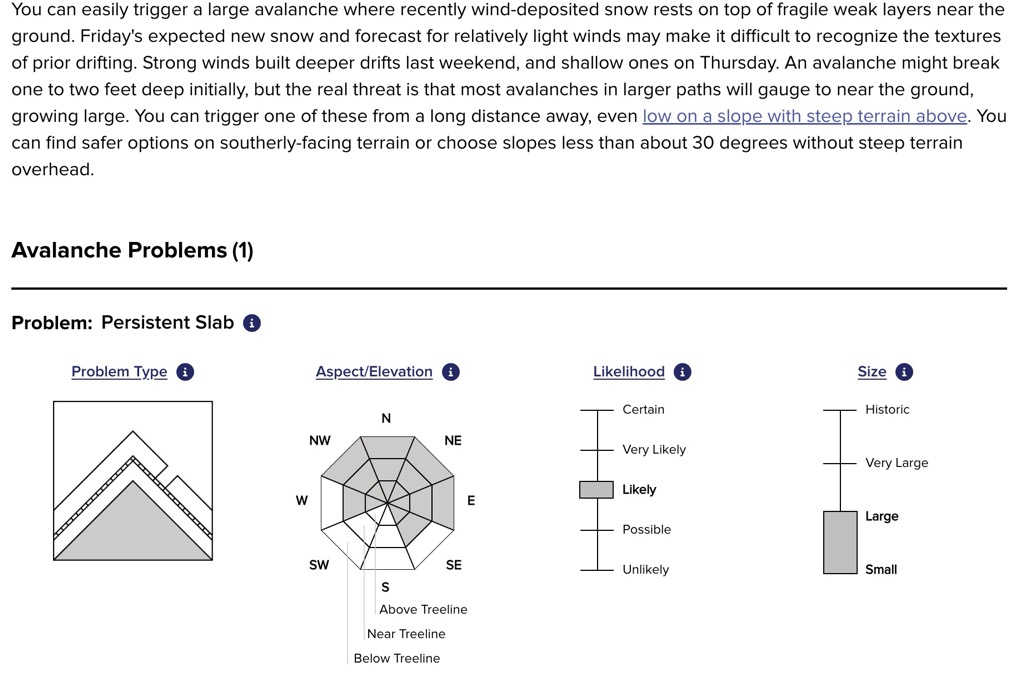
You can find your local avalanche forecast using www.avalanche.org. They don’t do the forecasts themselves. Instead, they have user-friendly maps and links to local avalanche centers throughout the U.S., Canada, Europe, and New Zealand. These local centers are the ones who do the actual field observation and forecasting.
You should use Google to scope out your local avalanche center outside these places. If your area doesn’t have one, you’ll have to stay on top of the local conditions yourself.
Avalanche Warning Signs
Even if you religiously check the avalanche forecast, you are not genuinely aware until you recognize avalanche warning signs.
‘Whumpfing’
‘Whumpfing’ is technically an onomatopoeia, meaning it is meant to sound like the thing it describes. However, it’s difficult to understand what ‘whumpfing’ sounds like until you hear it. It’s like distant, muffled thunder. Sometimes, it’s like it’s coming from off in the distance, even though it’s happening right below you.
Whumpfing is the sound of unstable layers in the snowpack collapsing on top of each other. It’s the most serious red flag you’ll encounter; no stable snowpack makes this sound, and when you do hear a big ole whumpf, it means the snowpack is a house of cards.
Shooting Cracks
It’s normal to see cracks suddenly appear in the snow around your skis, especially when skiing in fresh snow. However, if these cracks extend several meters away from you, it’s a warning sign. It means that the snowpack has a weak layer, and slabs have the potential to be cohesive and large enough to do damage.
Recent Avalanche Activity
Have a look around. Are there any signs of recent avalanches? These could include crowns or debris fields.
You may not have a good vantage point of the mountains from wherever you’re recreating, i.e., a ski tour that stays below the treeline most of the time. Often, avalanche centers will have a report log of the activity in the area. You can use this as an additional resource to analyze recent activity.
Recognizing Trigger Points
Certain types of terrain commonly feature weaker layers that are more conducive to a skier-triggered avalanche.
- Concave Rollovers: this type of mid-slope steepening is hard to see from above and can take skiers by surprise.
- Rocks: areas with lots of rocks, especially on slopes that are otherwise clean, often feature a shallower snowpack, which can be susceptible to the weight of a skier. Small vegetation, like willow branches poking up, often points to the same issue.
- Cornices: they form on the leeward side of ridgetops and can collapse under the weight of a skier. Generally, leeward terrain tends to have wind loading that can take skiers by surprise.
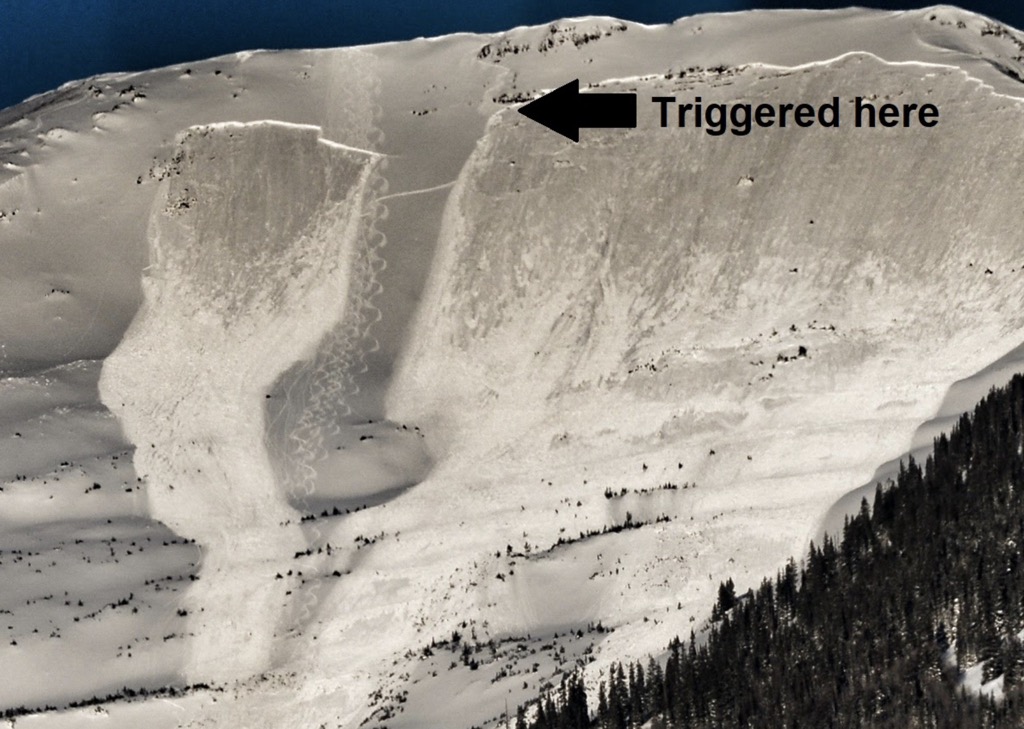
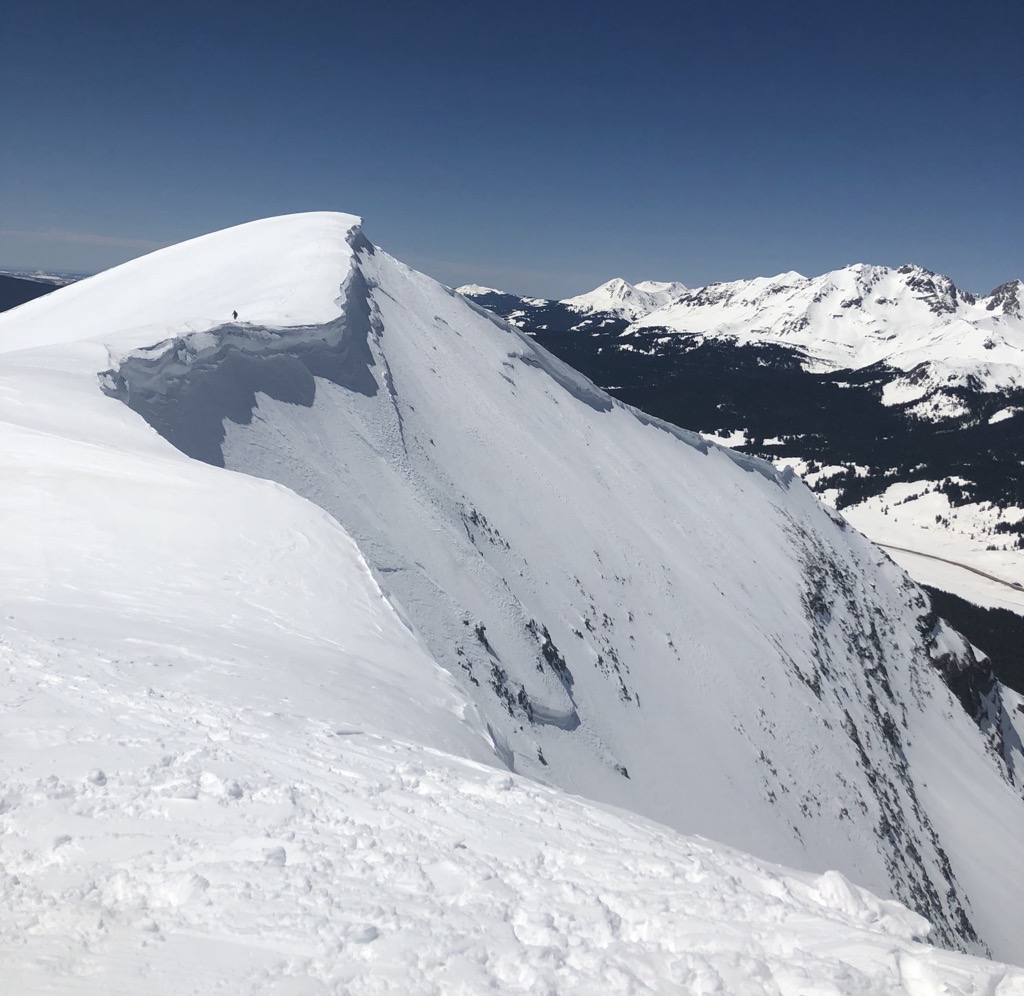
Terrain Traps
Terrain traps are mountain features that heighten the consequences of getting caught in an avalanche in a specific area. For instance, cliffs below a large face would be a terrain trap if that face were to slide; even if the slide wasn’t very large or destructive, getting swept over cliffs is not a good outcome.
Terrain traps can be trees, rocks, cliffs, crevasses, and - importantly - gullies. While most other terrain traps will cause trauma, gullies are the primary cause of lethally deep burials. That’s because avalanche debris fills these depressions like a lake, often burying skiers under many meters of snow.
Partners
Partners are a blessing in the mountains. Without a partner, you might as well be skiing without a beacon. In the event of an accident, you’re out of luck. I’ve known many people who could have been easily rescued (not deeply buried, etc.) had they been skiing with others.
The flip side is when groups become so large that they are burdensome and tricky to manage. The avalanche disaster at Tunnel Creek in Stevens Pass, Washington, is the best-documented example of a group that was way too large, and how it came to be.
The ideal group size is 3-4 individuals. Not too large to be inefficient, but large enough so that if one or two group members get buried, there will still be help. This isn’t limited to avalanches; you’ll be thankful to have partners if you break your leg, hit your head, or do anything else that limits your ability to self-rescue on your own.
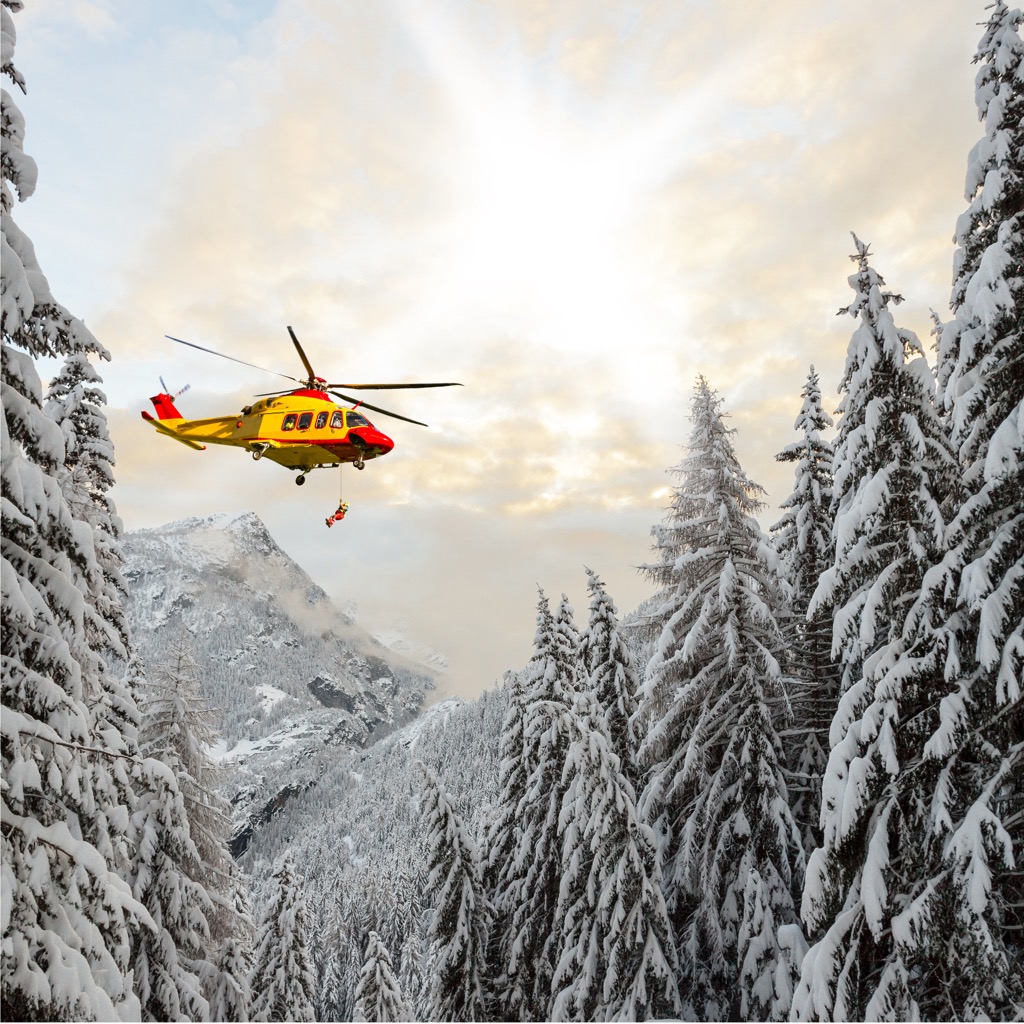
Using the PeakVisor App to Mitigate Avalanche Risk
The team at PeakVisor is constantly working to improve our tools for the mountains. Both the mobile and desktop versions of our app currently offer several tools that you can use to mitigate your risk.
One of the most obvious ways to reduce risk is by avoiding the most prone slopes. PeakVisor’s slope angle feature color codes everything above 30 degrees. You can check ski touring routes and individual coordinates, and evaluate your exposure on the trail.
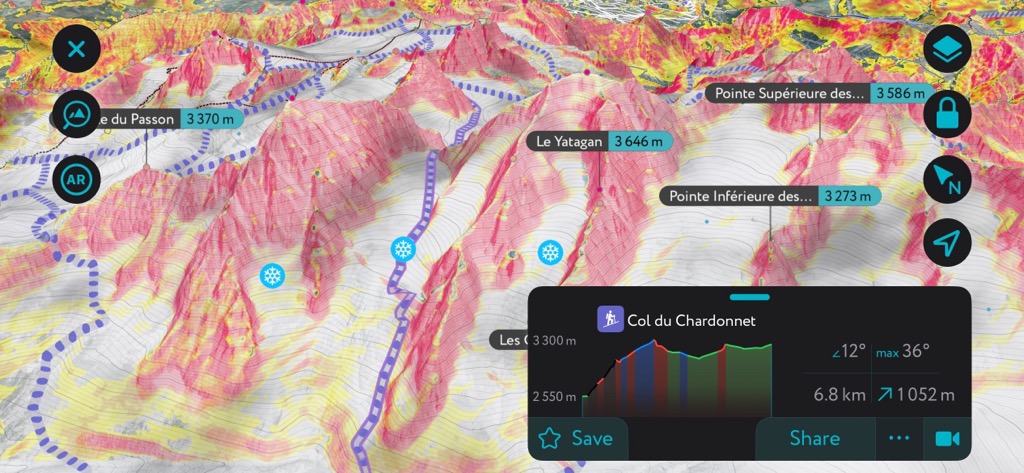

Understanding aspects is critical for finding the best snow and avoiding slope-specific avalanche problems. All our maps show a compass, where you can toggle direction.
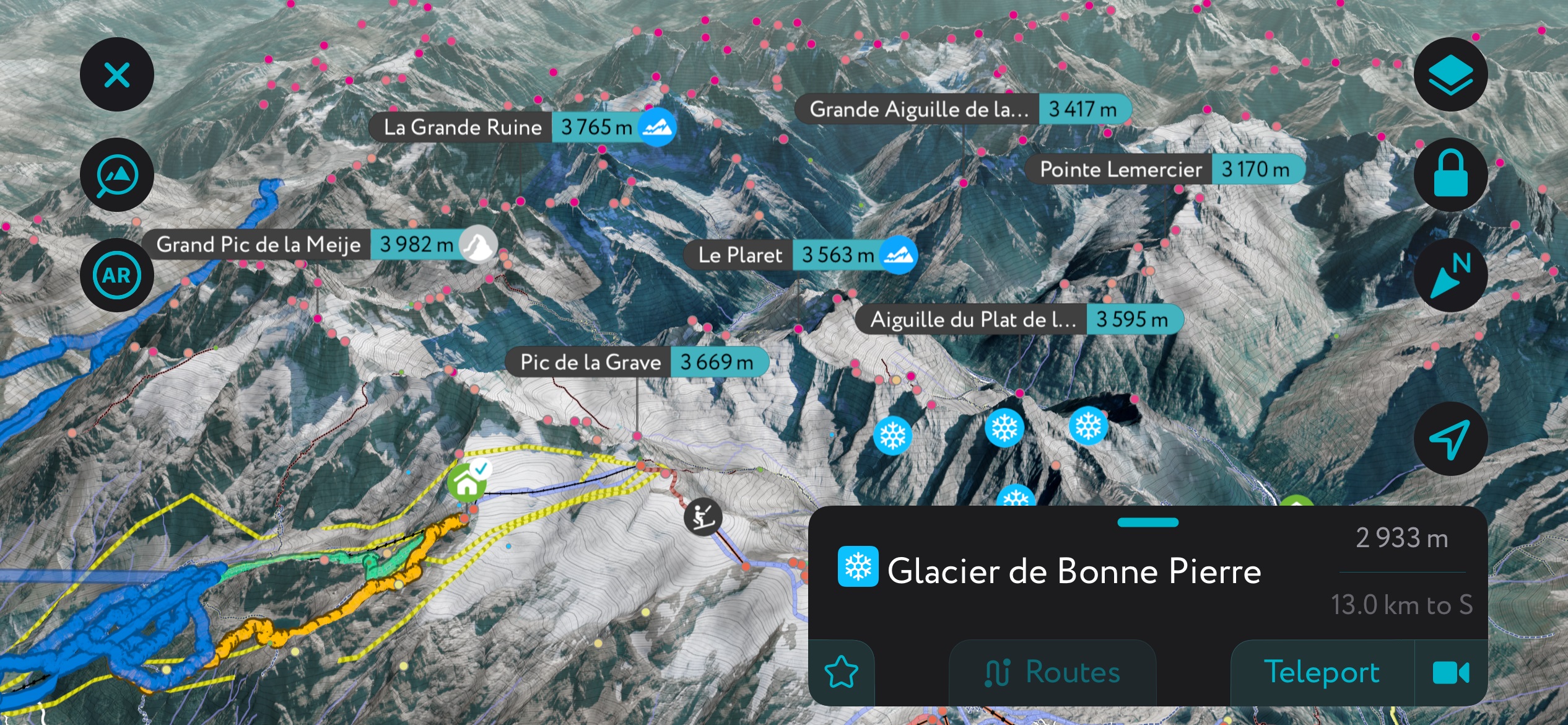
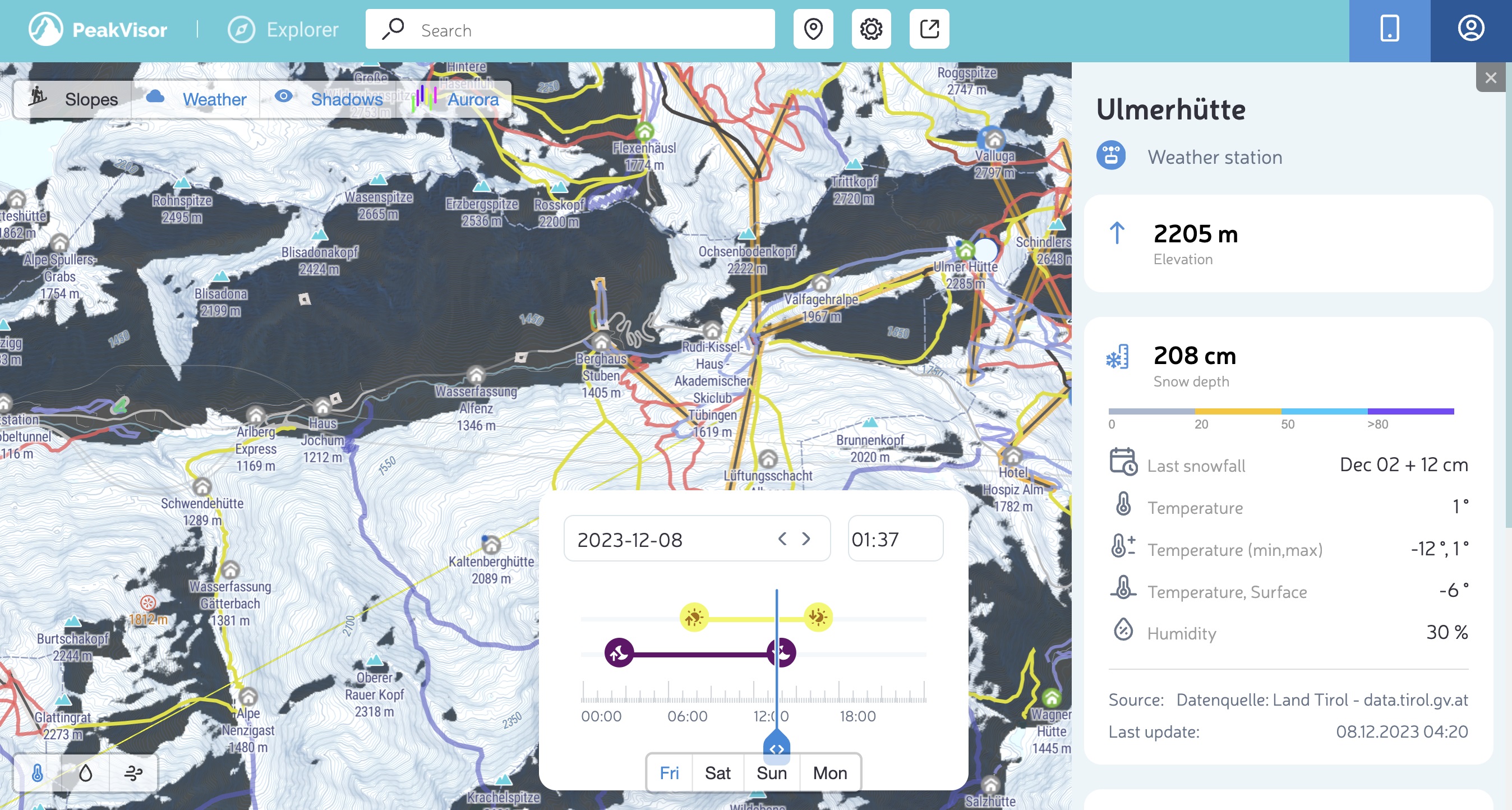
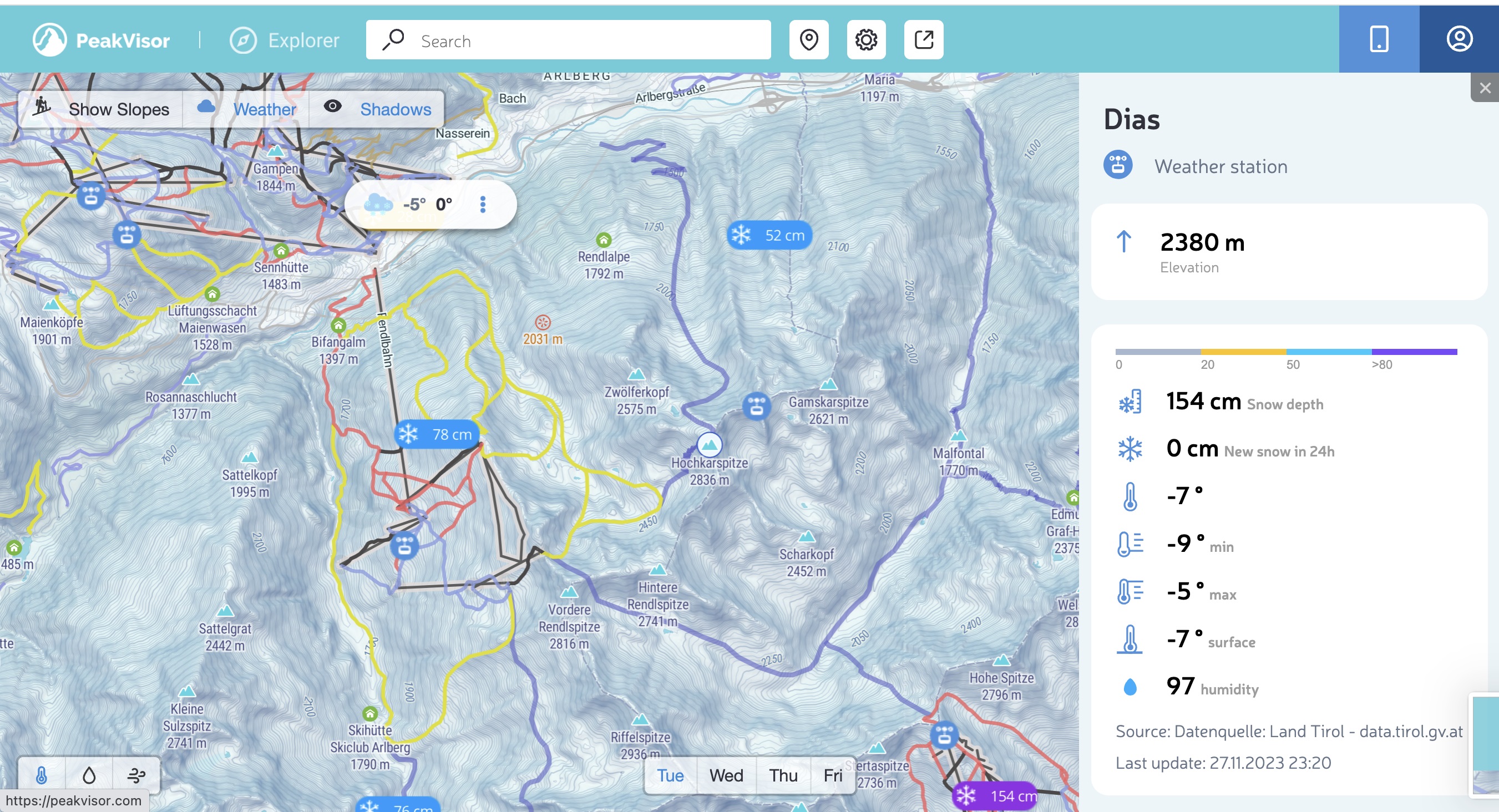
Getting Caught in an Avalanche
Not all skiers who trigger avalanches will get caught. Sometimes, the slab breaks at your skis and slides harmlessly away below you. Sometimes, you can ski out. Other times, you might get swept off to the side like an eddy. However, skiers caught in the middle of a giant slide have very similar descriptions of the experience.
What Is It Like Getting Caught in an Avalanche?
Many skiers and riders have described the experience of getting caught in a slide. Here are a few recurrent points everyone seems to make:
- Complete loss of control. You are a literal rag doll getting tossed around. Many people have described it like being in a washing machine or whitewater rapids in a river.
- Snow everywhere. In your nose, mouth, jacket, pants, down your back, and even stuffed into your ears and behind your eyelids. It’s hard to breathe once you're swept up.
- You go really, really fast. Like, the same speed as if you were straightlining down a black piste. Avalanches can quickly reach above 100 kph (62 mph). The largest ones can reach 320 kph (200 mph), but these are unsurvivable and not likely to be skier-triggered anyways.
- As soon as the slide stops, being stuck in avy debris is like being frozen solid in cement.
What to Do if You’re Caught in an Avalanche
If you feel yourself getting caught in the slide, there’s not much you can do. As we established, you don’t have much in the way of free will; the avalanche's power dominates your provenance. Nevertheless, here are some steps to follow:
- If you have an airbag, pull the trigger.
- Try grabbing a tree, rock, or anything that could arrest your impending immersion.
- Cry out to alert people of the slide and your situation.
- Once you’re in the slide, there will likely be a period of just tumbling where you are incapable of doing anything. Hopefully, you’ll avoid any obstacles and survive this. Keep your teeth clenched and mouth closed to avoid getting your airway stuffed full of snow. The slide will likely begin to slow down at a certain point, and you will stop tumbling so much. If you can, try to swim to the surface. Without an airbag, your body is denser than the snow and will naturally sink.
- If you suspect you will be buried, make an air pocket in front of your face and keep trying to reach for the surface with an arm. If one arm pokes out, it dramatically hastens the rescue process (no beacon search).
- If you are able to extricate yourself quickly, begin a beacon search for other victims. The clock is ticking.
- If you’re buried, remain calm and hope that it’s not too deep and you have good partners. You want to use as little oxygen as possible.
Avalanche Rescue
First off, here’s the most important thing with avalanche rescue: You must practice and become as efficient as possible. Learning how to use your beacon is easy, but you're losing precious time if you're not efficient at searching, probing, and shoveling. The difference between, say, 15 minutes and 9 minutes may be life and death.
I can describe the basics of rescue, but it’s something you have to learn hands-on. You can also start by watching one of many excellent YouTube videos. In the video, Chris Rubens and Greg Hill agree that you must take a course to dial in these skills.
Beacon Search
- Hopefully, you are above the person who got caught in the avalanche. If not, you must climb back up the slope, which is arduous or even impossible, depending on the conditions. Even in the best of situations, you’re losing precious time.
- If you’re above them, you’ll have to deal with the threat of additional avalanches while skiing down and while searching. There may be a situation where you can’t safely reach the victim. In many disasters, rescuer deaths outnumber the original victims; don’t become a part of this statistic.
- Beacons go on search mode, and cell phones go on airplane mode to reduce interference (it does make a big difference, in my personal experience).
- Traverse along a swatch of the avalanche debris where you think the person might be buried, usually the toe of the slide. Traverse back and forth down the slope in a zig-zag pattern until you pick up a signal. This is harder than it sounds, depending on how the avy debris has set up.
- Once you find a signal, move toward it and get the closest possible reading you can.
Probing
- Once you have the closest reading, start probing around the area until you feel a strike. You’ll likely know a strike when you feel one; it’s much different than the surrounding snow.
- When you get a strike, leave the probe in place.
Shoveling
- Start shoveling downhill from your probe, toward the bottom of the probe.
- Don’t shovel snow like in your driveway; the technique is more like breaking off chunks of avy debris and pushing them downhill, rather than lifting and tossing them away. You need to move as much snow as humanly possible in the shortest amount of time.
- Once you reach the victim, uncover their face as soon as possible.
You’ve got about 10 minutes to complete this entire process before the victim is at risk of severe brain damage or even death. After 25 minutes, it’s essentially over. Yeah, when you think about these numbers, you begin to realize how important it is NOT to get buried in an avalanche.
If the victim is not breathing when you uncover them, administer CPR. Overall, CPR has a 2% success rate. However, avalanche burial and drowning victims have by far the highest rates of resuscitation via CPR because, generally, there is no real structural damage to the heart. In many other cases, CPR is unlikely to work because there is already so much structural damage to the heart, i.e., heart attacks.
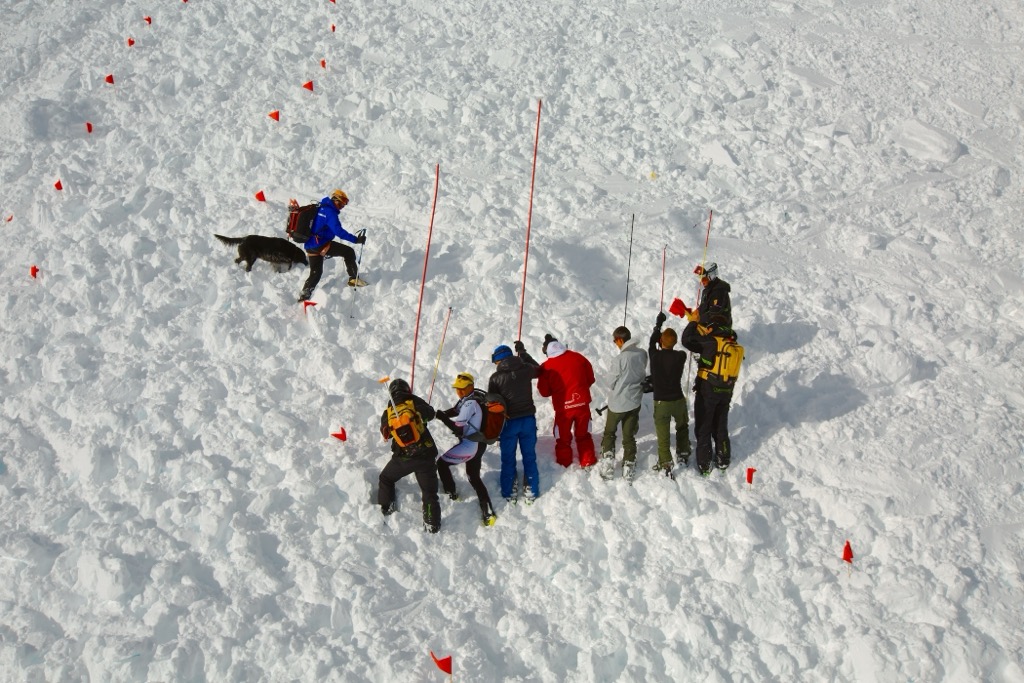
Avalanche Control and Rescue at Ski Resorts
Ski resorts are excellent places to gain experience in off-piste skiing. While you may not be able to find as much untracked powder snow, ski resorts are subject to extensive avalanche control. There are several ways resorts limit avalanche activity:
- Closed terrain. All resorts close certain terrain when avalanche danger is high enough.
- Giant pipes implanted at avalanche start zones release a cloud of gas and light it, causing an explosion. These explosions produce enough force to trigger any layers weak enough for a skier to break off.
- Ski patrol will ski around the mountain and actually drop physical bombs at start zones, hoping to clear out any slabs.
- Bombs are attached to cable systems and dropped off at start zones.
- Ex-military artillery is used to launch explosives onto start zones.
- Fences can be built at opportune locations (i.e., along the leeward side of a ridge), preventing the build-up of slabs.
- Ski-cutting.
- Skier compaction. The fact that skiers are constantly skiing around, packing down the snow, and breaking up slabs every day makes a huge difference.
Resorts also have trained personnel to assist with rescues. The fact that you have a ski patrol with snowmobiles (or other transport), avalanche dogs, first aid, medical training, and knowledge of the terrain to assist in the case of an accident is essential. Few skiers are likely to be as efficient at avalanche rescue as ski patrol. It is their job; they are professionals. Many have responded to and rescued avalanche victims before.
Accidents still happen at resorts, but if you compare the rate of skier hours/avalanche deaths, the rate is very low. You’re much more likely to die in a crash on a piste.
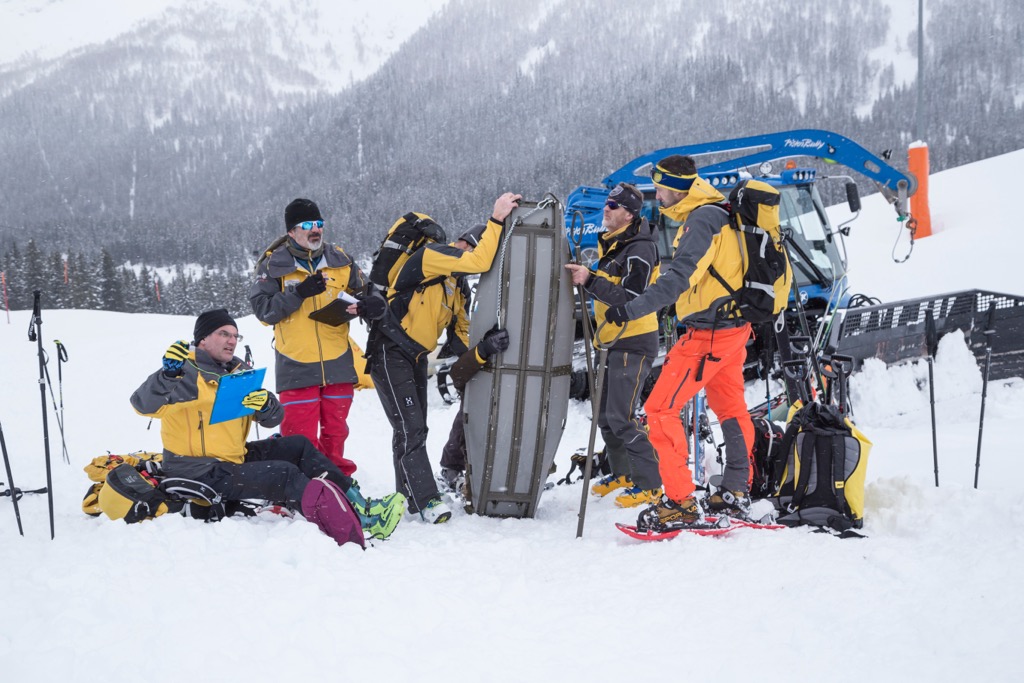
Risk Acknowledgment and Acceptance in Backcountry Skiing
Backcountry skiing is an inherently risky activity, and no amount of knowledge can completely eliminate the risk of avalanches or other hazards. You need to have some luck on your side at a certain point. You also need to have a risk tolerance. Different people have various risk tolerances; professional athletes pushing the limits of the sport have accepted the fact that they could die, while new fathers may be satisfied with conservative line choices that provide the lowest level of risk.
You can lower your risk by educating yourself as much as possible on avalanches and every aspect of skiing and movement in the mountains. There are many hazards, and being aware of them is an advantage for survival.
However, I also firmly believe that the risks of backcountry skiing are not high enough to justify a boycott of the sport. One statistician attempted to offer a way to view the risks numerically:
“In 2009, Bruce Jamieson, a professor of civil engineering at the University of Calgary in Alberta, Canada, took accident data collected in North America and Switzerland to come up with a risk-comparison chart. The data was presented in “millimorts,” or one death per million. One millimort is the chance an average 20-year-old male has of dying from any cause on any day.
Himalayan climbing turned out to be the riskiest activity Jamieson considered, with a one in 40 chance of dying on an 8,000-meter peak, or 12,000 millimorts. Riding a motorcycle eight hours a day earned 605 millimorts, while backcountry skiing in Canada, using usual risk-reduction practices, came in at four.”
The Denver Post Opinion Column, February 15, 2023
Is Climate Change Causing More Avalanche Deaths?
The quick answer is it’s inconclusive. It’s debatable whether research could ever come to a conclusion on this topic, as there are so many variables to contend with. However, changes are happening, and here’s how they may affect skiers now and in the future.
- While mountain snowpack diminishes, research shows that some slide paths appear to be experiencing more avalanches. Climate change has increased the persistence of weather patterns. Dry spells have been longer and drier. Wet spells have been warmer and wetter. Large storms after dry periods tend to result in a lot of avalanche activity.
- Snowpacks appear to be getting more unpredictable, at least compared to historically established patterns.
- Large-scale serac falls and glacial collapses have increased. Most of these events occur far off in the wilderness, but they have caused some lethal accidents in recent years, like the Marmolada Glacier collapse that killed 11 people in Italy.
- Looking back at tallies of avalanche deaths in the U.S. and Europe, it’s clear that the deadliest years are the snowiest, when the most people go out into the backcountry to ski powder. However, it’s possible (though impossible to measure) that the risk per skier hour in the backcountry is actually lower on these years than during the lean years.
- In my personal experience, dry years have much less predictable and stable snowpacks, and it’s easier to trigger slides as a skier because the weak layers are closer to the surface. But the skiing is not as good, so you’re not tempted to spend as much time out there.
Conclusion
When it comes to avalanches, no online article or video can substitute for comprehensive instruction and firsthand experience. This article is simply an introduction to the world of avalanches that you will familiarize yourself with over time if you pursue off-piste skiing.
Don’t forget to check out our app for some of the best tools modern technology has to offer. If you have any comments on the article, please email us at peakvisor@routes.tips! We love hearing from mountain enthusiasts of all sorts.

